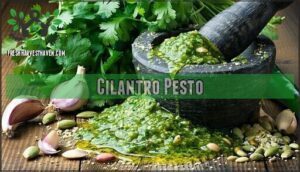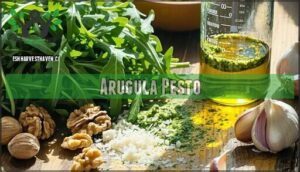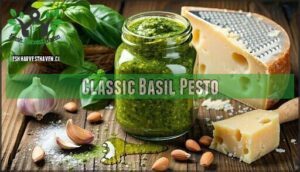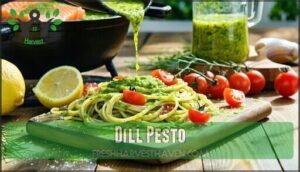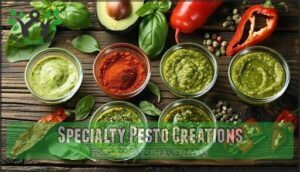This site is supported by our readers. We may earn a commission, at no cost to you, if you purchase through links.
 You’re not stuck with basil when making fresh herb pesto variations.
You’re not stuck with basil when making fresh herb pesto variations.
Try cilantro for Mexican dishes, parsley for Mediterranean flavors, or sage for earthy pasta sauces.
Mix herbs like dill with lemon zest, or blend tarragon with walnuts instead of pine nuts.
Even spinach works beautifully with garlic and parmesan.
The formula stays simple: fresh herbs, nuts, cheese, oil, and garlic blended until smooth.
Each herb brings its own personality—cilantro‘s brightness, mint‘s cooling freshness transforms ordinary meals into something special.
Table Of Contents
- Key Takeaways
- Classic Pesto Variations
- Herbal Pesto Combinations
- Fresh Herb Pesto Basics
- International Pesto Inspirations
- Specialty Pesto Creations
- Frequently Asked Questions (FAQs)
- What herbs can be added to pesto?
- What to use fresh pesto for?
- Can you make pesto with herbs other than basil?
- What other herbs can you put in pesto?
- How to make pesto more interesting?
- What else can I put in pesto?
- What is the difference between pesto trapanese and genovese?
- What is mixed herb pesto?
- Is pesto high in carbohydrates?
- Can you make pesto with other herbs?
- Conclusion
Key Takeaways
- You’re not limited to basil—experiment with cilantro for Mexican dishes, parsley for Mediterranean flavors, sage for earthy pasta sauces, or mint for cooling freshness that transforms ordinary meals.
- The basic formula stays simple across all variations: fresh herbs, nuts, cheese, oil, and garlic blended until smooth, allowing you to substitute ingredients based on your dish’s flavor profile.
- International variations like Thai peanut pesto, Vietnamese cilantro-mint combinations, and Peruvian spinach pesto prove that great pesto speaks every culinary language with local ingredients.
- You can create specialty pestos using unexpected ingredients like sun-dried tomatoes, roasted garlic, avocado, or seasonal vegetables—each bringing unique textures and flavors to expand your sauce repertoire.
Classic Pesto Variations
You’ll find these three classic pesto variations form the foundation of Mediterranean cooking, each bringing unique regional flavors to your kitchen.
Traditional basil pesto offers the familiar garlic-pine nut combination, while Trapanese pesto adds sweet tomatoes and crunchy almonds, and Sicilian pesto introduces creamy ricotta with aromatic pistachios.
Traditional Basil Pesto
With traditional basil pesto, you’re crafting culinary gold using five essential ingredients.
Fresh basil quality matters most—choose bright green leaves without dark spots.
Pine nut origin affects flavor; Italian varieties offer the richest taste.
Select aged Parmesan type like Parmigiano-Reggiano for depth.
Your olive oil choice should be extra virgin for authentic flavor.
Adjust garlic intensity to preference.
Preventing pesto browning involves adding lemon juice.
- This classic pesto recipe transforms simple ingredients into restaurant-quality sauce that’ll make your pasta sing.
Trapanese Pesto
Sicily’s pesto alla trapanese transforms traditional pesto with Sicilian flair—swapping pine nuts for regional almonds and adding fresh tomatoes.
You’ll crush ripe tomatoes with sweet almonds, fragrant basil, garlic, and sharp Pecorino cheese.
Regional differences shine through tomato selection and almond variety, while basil influence remains strong.
Some variations include pistachios from nearby Bronte, creating unique pesto variations that capture Mediterranean sunshine perfectly, with a focus on regional almonds.
Sicilian Pesto
Through ricotta’s creamy richness, you’ll discover Sicily’s unique twist on fresh pesto recipes.
Creamy ricotta transforms traditional pesto into Sicily’s luxurious culinary masterpiece.
This basil pesto variation combines ricotta cheese with tomato varieties like cherry or San Marzano, while pistachio quality from Bronte adds luxury.
Basil alternatives such as parsley brighten the mix, and garlic intensity balances sweet tomatoes perfectly in these homemade pesto variations.
Herbal Pesto Combinations
You’ll find that herbs beyond basil reveal entirely new flavor territories for your pesto repertoire, each bringing its own personality to the classic recipe.
From parsley’s fresh bite to sage’s earthy warmth, these herbal combinations let you match your pesto perfectly to whatever dish you’re creating, with complete concepts like these allowing for a more tailored approach, and thus enabling you to explore new flavor territories.
Parsley Pesto
Parsley pesto brings fresh flavor that’ll make your taste buds dance. This herb pesto recipe offers excellent nutritional benefits and versatile culinary applications.
- Pulse fresh parsley with garlic and lemon juice
- Add toasted walnuts for rich flavor pairings
- Stream olive oil while blending smooth
- Fold in Parmesan cheese
Perfect pesto variations herbs deserve proper storage tips—refrigerate up to one week. Try this parsley pesto on pasta, grilled chicken, or roasted vegetables for incredible recipe variations.
Cilantro Pesto
Cilantro brings zesty charm to your pesto recipe ideas, creating bold lime pairings that’ll make your taste buds dance.
Fresh cilantro transforms ordinary pesto into a zesty Mexican fiesta that’ll revolutionize your dinner table.
This vibrant cilantro pesto shines in Mexican and Asian dishes, where fresh herbs meet adventure. Try pumpkin seeds instead of pine nuts for crunch, add Cotija cheese for authenticity, or include a serrano pepper for heat.
Cilantro transforms traditional pesto variations into something extraordinary—perfect over grilled fish or mixed into quinoa salads.
Sage Pesto
Sage pesto transforms your kitchen adventures with its earthy flavor profile that’s perfect for winter pesto creations.
This robust sage blend complements hearty dishes beautifully.
- Pair with roasted pork, chicken, or beef for exceptional meat complements
- Mix with creamy goat cheese or sharp Parmesan for rich cheese pairings
- Add lemon juice to balance sage’s intensity in your pesto herb combinations
Tarragon Pesto
Tarragon’s anise-like flavor makes bold herb combinations that stand out from typical basil varieties.
You’ll love how tarragon pesto transforms with flavor pairings like hazelnuts or cashews, creating creamy depth.
This French herb’s unique tarragon origins shine in recipe adaptations for fish dishes and pasta.
Culinary applications expand when you experiment with parsley blends.
For storage methods, keep your pesto with herbs fresh by topping with olive oil in airtight containers.
Arugula Pesto
When you crave bold flavors, arugula pesto delivers with its distinctive arugula bitterness that pairs beautifully with walnuts or almonds.
This basil alternative transforms your pesto ingredients variations into something special.
You can even use walnuts as a substitute if pine nuts are unavailable.
The peppery bite works perfectly with creamy cheese choices like Parmesan or Pecorino.
Try this pesto with herbs over pasta, spread on sandwiches, or drizzled over grilled vegetables for exciting serving suggestions.
Fresh Herb Pesto Basics
You’ll master essential fresh herb pestos that form the foundation of countless variations.
These four core recipes teach you the techniques needed to transform any fresh herb into a flavorful sauce.
Classic Basil Pesto
Nothing beats the original! Classic basil pesto delivers that authentic Italian flavor you’re craving. Basil quality matters most—choose bright, aromatic leaves for maximum impact.
Here’s your foundation for perfect basil pesto variations:
- Pine nut alternatives like walnuts or almonds work beautifully
- Parmesan selection determines richness—aged varieties pack more punch
- Oil emulsification creates that silky texture when drizzled slowly
Garlic intensity balances the sweet basil perfectly in these timeless pesto recipes. You can even find options for organic fresh basil online.
Mint Pesto
Mint pesto transforms your kitchen into a fragrant oasis with its sweet, cooling flavor that’ll make your taste buds dance.
This revitalizing pesto recipe with herbs creates incredible mint pairings that work magic on everything from grilled lamb to roasted vegetables.
Here’s your mint pesto roadmap:
- Blend fresh mint with pistachios or almonds for nutty depth and perfect flavor profiles
- Balance with garlic and Parmesan to tame mint’s intensity while adding savory richness
- Store in airtight containers with oil covering the surface for maximum freshness
These recipe tweaks reveal countless culinary uses and pesto herb variations that’ll revolutionize your cooking game.
You can find the necessary mint pesto ingredients online.
Lemon Balm Pesto
Lemon balm’s gentle citrusy notes create surprisingly sophisticated pesto flavor combinations that’ll make your taste buds sing.
This herb brings lemon balm flavor that’s more mellow than harsh lemon zest, perfect for culinary pairings with delicate seafood or creamy pasta dishes. You’ll discover health benefits too – lemon balm naturally soothes stress while adding fresh zing to your meals.
A vital step is to verify fresh basil leaves are vibrant and free of dark spots.
Here’s your foolproof recipe approach:
Recipe tweaks work wonders here – try swapping pine nuts for almonds or adding mint for complexity. Growing lemon balm yourself guarantees peak freshness, and this pesto recipe with herbs freezes beautifully for year-round enjoyment of your homemade pesto sauce ideas.
Dill Pesto
Dill pesto brings a fresh, feathery twist to your herb substitutions arsenal. This creamy dill creation pairs beautifully with salmon pesto dishes, transforming ordinary meals into restaurant-worthy experiences.
The unique additions of dill nutrition and bright flavor make this pesto sauce with herbs incredibly versatile. Perfect dill pairing moments include a variety of dishes that can be enhanced by the flavor of dill.
- Dolloped on grilled salmon with lemon wedges
- Swirled into creamy pasta with cherry tomatoes
- Spread on bagels with cream cheese and capers
- Tossed with roasted potatoes and fresh herbs
Fresh herb pesto using different herbs like dill creates exciting flavor profiles you’ll crave repeatedly. You can find products related to dill pesto recipes online.
International Pesto Inspirations
You’ll discover that pesto traditions extend far beyond Italy, with each culture adding its own signature ingredients and flavor profiles.
From Thailand’s peanut-based versions to Peru’s spinach creations, these international twists prove that great pesto speaks every language.
Thai Peanut Pesto
Why settle for ordinary when Thai peanut pesto brings bold flavor balance to your kitchen?
This fusion marvel combines roasted peanuts, Thai basil, and chili variations for incredible pesto flavor ideas.
Perfect for noodle pairings and vegan options, it’s easily adapted for peanut allergies using sunflower seeds.
Regional twists make this basil alternative endlessly customizable with creative pesto ingredients.
Vietnamese Pesto
Breaking away from traditional basil, Vietnamese pesto brings Ginger-Lime Balance and exotic flair to your kitchen.
This Nuoc Cham Pesto transforms cilantro, mint, and Thai basil into something magical with Fish Sauce Umami depth.
Here’s your flavor roadmap:
- Mint-Basil Ratio: Equal parts Thai basil and mint for authentic taste
- Cilantro-lime pesto base with roasted peanuts instead of pine nuts
- Fish sauce adds that signature Vietnamese Cuisine punch
Perfect basil alternatives for adventurous cooks seeking bold pesto flavor ideas with fresh herbs.
Turkish Pesto
Turkish pesto showcases Turkish ingredients like pistachios, parsley, and mint, creating unique pesto recipes that deliver incredible garlic intensity.
These basil alternatives offer regional twists on traditional pesto sauce variations, maintaining pesto authenticity while exploring bold herb variations.
Perfect culinary pairings include:
- Mezze spreads with warm flatbread
- Grilled lamb and chicken kebabs
- Bulgur pasta dishes
- Roasted eggplant salads
Peruvian Spinach Pesto
Looking beyond Turkish variations, Peruvian spinach pesto (Tallarines Verdes) brings South American flair to your pesto variations list.
This unique pesto recipe swaps basil for nutrient-packed spinach and adds queso fresco with evaporated milk for incredible creaminess. The pecan substitution keeps costs down while delivering rich flavor.
Recipe adaptations in Peruvian cuisine showcase how fresh ingredients create magic.
| Component | Traditional Pesto | Peruvian Spinach Pesto | Benefits |
|---|---|---|---|
| Greens | Basil | Spinach + some basil | Higher iron, vitamin A |
| Cheese | Parmesan | Queso fresco | Milder, creamier texture |
| Liquid | Olive oil | Evaporated milk + oil | Sweet richness, lower sodium |
| Nuts | Pine nuts | Pecans/cashews | Budget-friendly, local availability |
Specialty Pesto Creations
You can transform ordinary ingredients into extraordinary pesto creations that’ll surprise your taste buds and impress your dinner guests.
These specialty variations combine unexpected elements like sun-dried tomatoes, roasted vegetables, and creamy avocado to create pestos that work as pasta sauces, sandwich spreads, or dips for your next gathering.
Sun-Dried Tomato Pesto
Sun-dried tomatoes transform ordinary pesto into a bold, umami-packed powerhouse.
This sundried tomato pesto delivers sweetness balance through caramelized tomato notes paired with fresh basil and quality olive oil. Perfect for homemade sauces enthusiasts!
Try these recipe pairings:
- Toss with pasta and fresh mozzarella for texture variations
- Spread on crusty bread with goat cheese
- Mix into grain bowls for an umami boost
Store covered in refrigerator for maximum freshness.
Roasted Garlic Pesto
Transform your kitchen with roasted garlic pesto’s sweet, caramelized magic.
Garlic caramelization happens when you roast whole bulbs at 375°F for 40 minutes—this creates nutty depth that’ll knock your socks off.
For nut selection, try walnuts instead of pricey pine nuts.
Cheese pairing works beautifully with sharp Parmesan cheese and quality olive oil.
Add fresh herb additions like basil for extra flavor.
This homemade sauce’s recipe versatility shines with pasta, bread, or grilled vegetables.
Technique Details
Squash-Pine Nut Pesto
From roasted garlic’s mellow sweetness, squash-pine nut pesto brings autumn’s warmth to your table.
You’ll love how Squash Varieties like butternut or delicata create creamy, naturally sweet bases that balance perfectly with toasted nuts’ earthy crunch.
Here’s your game plan for squash-pine nut pesto mastery:
- Roast cubed squash until caramelized edges develop golden-brown sweetness
- Toast pine nuts in a dry skillet until fragrant and lightly golden
- Blend roasted squash with toasted nuts, garlic, and fresh herbs
- Add Pecorino Romano for sharp, salty contrast against sweet squash
- Drizzle olive oil slowly while processing for silky, spreadable consistency
Pine Nut Toasting transforms bland nuts into aromatic powerhouses.
Cheese Pairing with Pecorino creates perfect Sweetness Balance – the sharp, salty cheese cuts through squash’s natural sugars.
Recipe Adaptations work beautifully; swap walnuts for pine nuts or add sage for earthier nutty flavors.
This different pesto recipes approach proves squash-pine nut pesto deserves a spot in your seasonal rotation.
Lemon Zucchini Pesto
Lemon zucchini pesto brings summer recipes to life with grated zucchini’s subtle zucchini texture and bright lemon juice.
The lemon intensity balances perfectly with hazelnut pairing, creating creamy variations that coat pasta beautifully.
Zucchini can also be prepared using various cooking methods, impacting its texture.
Try almonds for different textures—they’re fantastic too!
This lemon and mint combo offers invigorating serving suggestions: toss with warm pasta, drizzle over grilled vegetables, or spread on crusty bread for an instant flavor boost.
Avocado Pesto
While zucchini adds subtle freshness, avocado pesto delivers rich, creamy texture that transforms any dish.
This vegan-friendly powerhouse combines health benefits with incredible versatility, making it your go-to for fresh tastes.
Here’s how to nail perfect avocado pesto:
- Lime juice prevents browning and adds brightness
- Spinach boosts nutrition without overpowering avocado
- Walnuts or pistachios provide satisfying crunch
- Chili flakes bring gentle heat
- Bold garlic creates depth and complexity
Recipe adaptations are endless with this crowd-pleaser!
Frequently Asked Questions (FAQs)
What herbs can be added to pesto?
You’ll trigger a flavor explosion by swapping basil for parsley, cilantro, mint, arugula, sage, or tarragon.
Each herb brings its own personality—cilantro’s zesty kick, sage’s earthy warmth, or arugula’s peppery bite transforms your pesto completely.
What to use fresh pesto for?
You can toss fresh pesto with pasta, spread it on sandwiches, drizzle over grilled chicken or fish, mix into salads, or dollop on pizza for instant flavor.
Can you make pesto with herbs other than basil?
With 38+ documented pesto variations, you’re not stuck with just basil.
You can craft delicious pestos using parsley, cilantro, mint, arugula, kale, or even carrot greens—each bringing its own flavor personality to your kitchen adventures.
What other herbs can you put in pesto?
You can experiment with parsley, cilantro, sage, arugula, mint, kale, spinach, or tarragon.
Each herb brings unique flavors—parsley’s freshness, cilantro’s zest, sage’s earthiness, or arugula’s peppery bite transforms your pesto completely, with unique flavors that can enhance your dish.
How to make pesto more interesting?
Transform your boring pesto into a flavor powerhouse by mixing unexpected herbs like tarragon with parsley.
Adding roasted red peppers for smokiness can also enhance the flavor.
Swapping pine nuts for pistachios and toasted almonds is another option to consider.
What else can I put in pesto?
You can add roasted vegetables like bell peppers or sun-dried tomatoes.
Different nuts like walnuts or pistachios can also be added, along with extra citrus zest, or spicy peppers.
Additionally, you can include creamy additions like avocado or ricotta cheese.
What is the difference between pesto trapanese and genovese?
Before smartphones existed, you’d grind trapanese pesto by hand, mixing tomatoes, almonds, basil, and Pecorino for Sicily’s lighter style.
Genovese uses pine nuts, garlic, Parmesan—no tomatoes—creating Italy’s classic green sauce.
What is mixed herb pesto?
Mixed herb pesto combines multiple fresh herbs like basil, chives, coriander, and parsley instead of using just one.
You’ll create complex, layered flavors that dance on your taste buds with this versatile twist.
Is pesto high in carbohydrates?
Think of carbs as fuel for your engine—pesto isn’t exactly premium gasoline.
You’re looking at roughly 2-4 grams of carbohydrates per tablespoon, mainly from garlic and cheese, making it a low-carb powerhouse for your culinary adventures.
Can you make pesto with other herbs?
You can absolutely make pesto with countless herbs.
Try parsley, cilantro, mint, arugula, sage, or tarragon instead of basil.
Each herb creates unique flavors – cilantro adds a zesty kick, while sage brings earthy richness.
Conclusion
Exploring fresh herb pesto variations opens a world of culinary possibilities beyond the familiar green standard.
You’ve discovered that cilantro transforms Mexican dishes, while sage elevates pasta with earthy sophistication.
Parsley brings Mediterranean brightness, and mint adds cooling freshness to summer meals.
Each herb combination creates distinct flavor profiles that’ll revolutionize your cooking.
Don’t hesitate to experiment with different nuts, cheeses, and oils.
Your kitchen adventures with these fresh herb pesto variations will turn simple ingredients into extraordinary sauces that impress family and friends alike.


